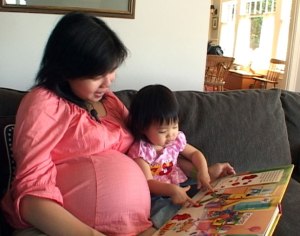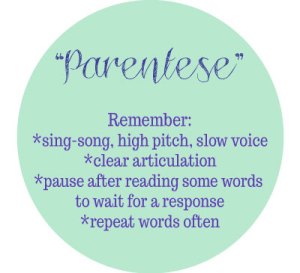SEL Parent Workshops: How Group Dynamics Enhance Problem-Solving and Parenting Skills

Check out our blog for social-emotional learning articles, news, and more!
Written by: Carolyn Webster-Stratton, Ph.D
Toddlers have a wide range in attention span that will vary by the moment daily. When reading with your toddler, don’t worry if she/he seems restless and gets off your lap. Keep reading. If your toddler seems more interested in another activity, wait and try to read again later.
 Comment and describe objects, colors, body parts, emotions, and actions of pictures in books. Talk about the pictures in your native language while you point to the pictures and/or make up stories. Take turns interacting and let your child turn the pages and point to pictures while you name them. If your child doesn’t have much language yet, remember toddlers understand much more than they can speak. Mirror and imitate the sounds your child makes and use simple words to describe objects. Read for a few minutes at times when your toddler seems calm and alert.
Comment and describe objects, colors, body parts, emotions, and actions of pictures in books. Talk about the pictures in your native language while you point to the pictures and/or make up stories. Take turns interacting and let your child turn the pages and point to pictures while you name them. If your child doesn’t have much language yet, remember toddlers understand much more than they can speak. Mirror and imitate the sounds your child makes and use simple words to describe objects. Read for a few minutes at times when your toddler seems calm and alert.
 Ask a few open-ended questions and explore the book together.
Ask a few open-ended questions and explore the book together.
You might try asking a few  open-ended questions to see if your child will talk about their ideas. For example, you might say, “I wonder what will happen next?” Or, ” Do you think he is proud of doing that?” However, avoid asking too many questions or your child will think you are testing her/him and will close up if she/he doesn’t know how to answer the question. Rather ask questions that show you are genuinely interested in your child’s thoughts and intersperse them with descriptive commenting.
open-ended questions to see if your child will talk about their ideas. For example, you might say, “I wonder what will happen next?” Or, ” Do you think he is proud of doing that?” However, avoid asking too many questions or your child will think you are testing her/him and will close up if she/he doesn’t know how to answer the question. Rather ask questions that show you are genuinely interested in your child’s thoughts and intersperse them with descriptive commenting.
Examples:
Parent: “What do you see on this page?” (Toddler points to a truck)
Parent: “Yes that is a big, blue truck.”
Parent: “What’s happening here?” (Parent points to a picture)
Parent: “That is a yellow bus.”
Parent: “I wonder if there are two trucks?” (Prompting a pre-academic skill & child points to another truck)
Parent: “You are right, there is a blue and a black truck.”
Parent: “I wonder if she is feeling sad now?” (Exploring the name of feelings)
Parent: “What is going to happen next?” (Creating a feeling of excitement and discovery )
 Respond with smiles, encouragement, praise and expressive delight to your toddler’s efforts to respond. Follow your child’s lead and empower his or her discovery and exploration of the book. Use hand movements with your words. Slide your finger under the words or letters on the page and show left to right movement.
Respond with smiles, encouragement, praise and expressive delight to your toddler’s efforts to respond. Follow your child’s lead and empower his or her discovery and exploration of the book. Use hand movements with your words. Slide your finger under the words or letters on the page and show left to right movement.
Read using “parentese” language which sounds like this:
Examples:
“Wow that is a tall giraffe.”
“You are really thinking hard about that.”
“Wow, you know a lot about trains.”
“That’s awesome. You are learning about the names of so many animals and what they eat.”
 Expand on what your toddler says. You can expand by adding a new word or similar word to what he or she is saying or by reminding them of a personal experience or event in their life that is similar to the story in the book.
Expand on what your toddler says. You can expand by adding a new word or similar word to what he or she is saying or by reminding them of a personal experience or event in their life that is similar to the story in the book.
Examples:
“Yes, I think he’s feeling excited too, and he might be a little scared as well.”
“Yes, it is horse; it’s also called a mare.”
“Yes, that boy is going to the park. Do you remember going to the park with grandma?”
REMEMBER
• Read in a quiet place; turn off any competing noises such as TV, stereo, radio or computer. Even the phone should be turned off during this time.
• Allow your child to select the book from his/her favorites. Read books that reflect your toddler’s experiences such as taking a bath, getting ready for bed, or riding a tricycle or dressing in the morning.
• Hold your toddler in a comfortable position on your lap or if he/she is wiggly, allow him/her to read lying down or standing up.
• Allow children to re-read the same books as often as they wish. This is a pre-reading skill and leads to memorization of the story.
• Read to children every day and allow them to see you reading.
• Offer a variety of books such as folk tales, poems, informational books, fantasy, fables and adventure stories.
• Involve siblings and grandparents in reading to your toddler in their language.
For more information, see the Incredible Years Toddler program, as well as the book Incredible Toddlers: A Guide and Journal of Your Toddler’s Discoveries.
Content of this blog ©The Incredible Years®





